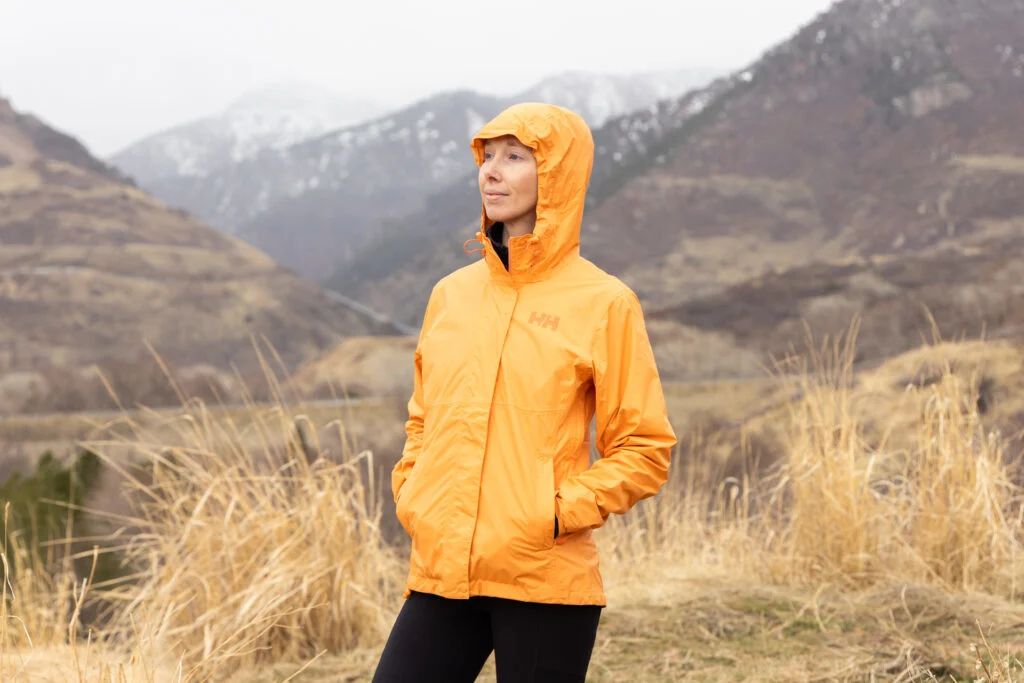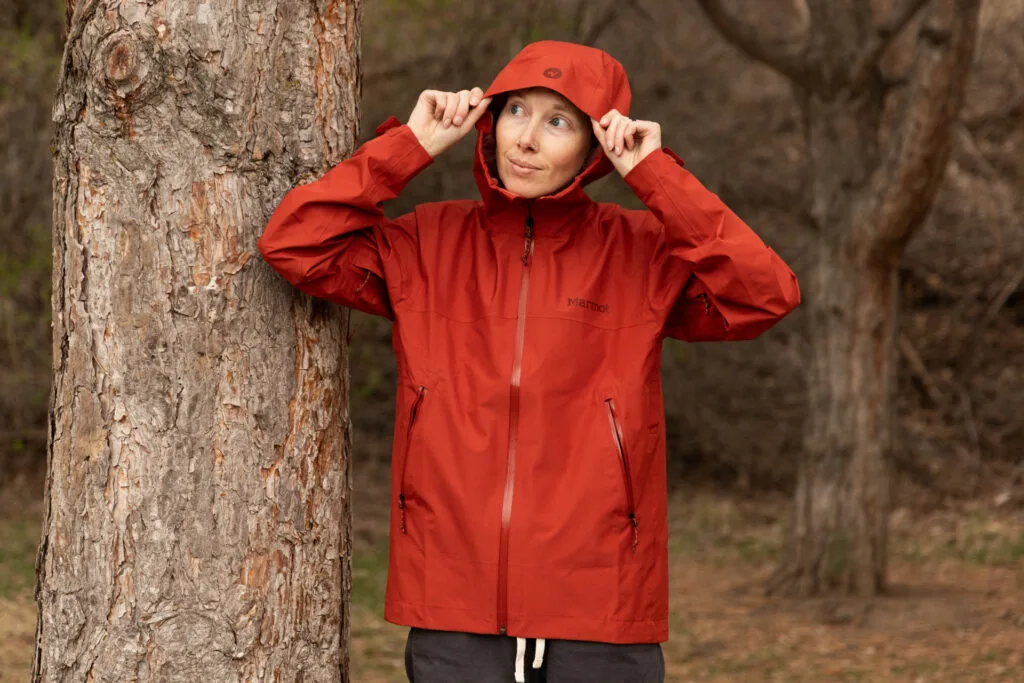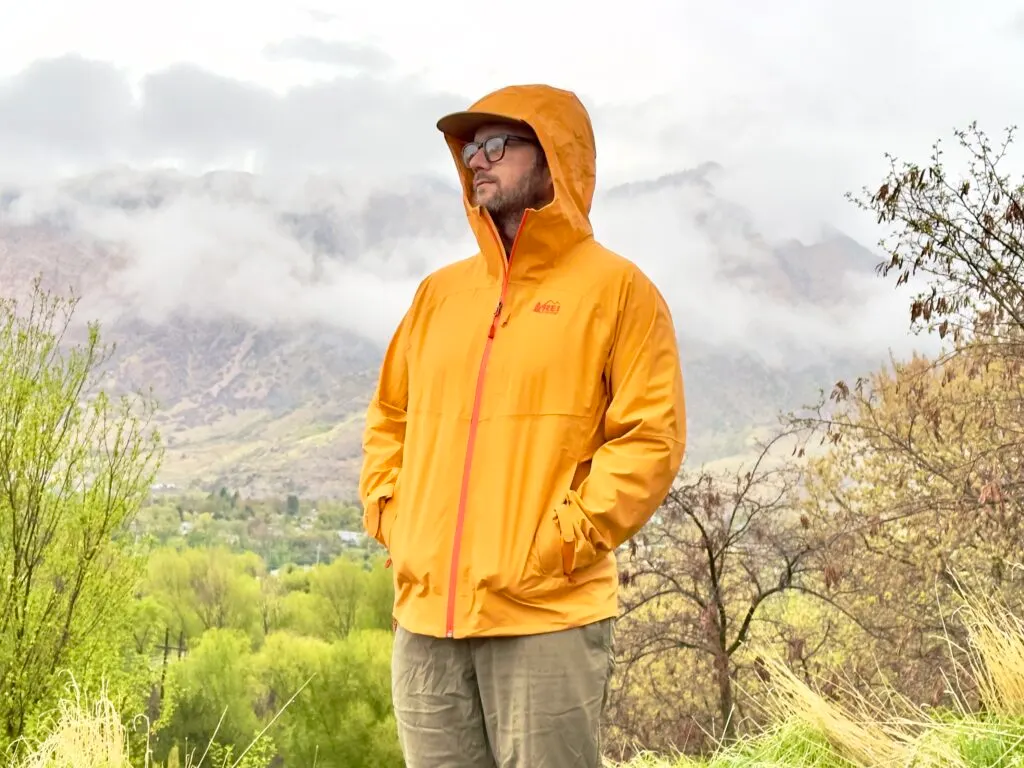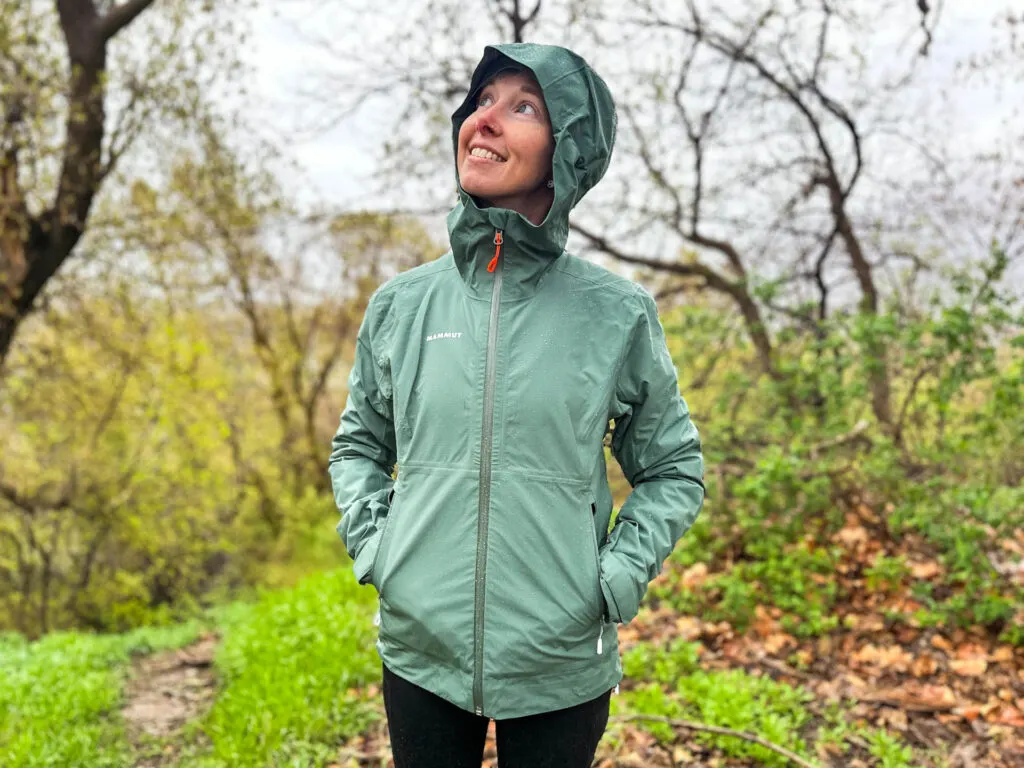The Best Deals on Camping, Backpacking and Outdoor Gear [June 2025]
You know what they say about April showers (don’t make me repeat the rhyme…)! But if you love the outdoors, you can’t let a little precipitation ruin your hiking plans. Heck no! Just don a rugged rain jacket and get out there to play (whether that involves walking your dog around the park or summiting the nearest fourteener). But not all rain jackets are created equal. When it comes to performance, but also sustainability. So if it’s time to replace your tattered old jacket, avoid rain gear with PFAS (read about why here) and choose one of these more sustainable rain jackets for hiking.
Has your current rain jacket lost its waterproofness? It may just need washed! Learn how to clean a rain jacket the right way here.
The Best Sustainable Rain Jackets for Hiking

Cotopaxi Impermeo 3L Rain Jacket
Cotopaxi Impermeo review: One of our favorite jackets on this list is surprisingly not from a technical apparel brand, but a super trendy (and sustainably-minded) one: Cotopaxi. Why is it so great? It has all the features you want in a rain jacket: zippered hand pockets and a zippered chest pocket, underarm ventilation (AKA pit zips), an adjustable hood (one way), a bungee in the hem, and velcro cuffs. The sleeves are plenty long enough for a person much taller than me. It even stows in its own pocket for travel. The hood is roomy enough to wear over a beanie or ball cap plus the laminated visor was large enough to keep rain off our glasses. But our favorite feature might be the material it’s made of: it’s soft to the touch and made of 4-way stretch so it always moved with us. That means it’s not the most waterproof jacket on this list, but it held up fine to rainy walks and hikes in Zion National Park when moisture was persistent and the fact that it’s a 3-layer construction means it’s going to be more durable and more breathable.
The jacket fits on the loose side, but in a good way with just enough room to layer over a cozy sweater or fleece. I find Cotopaxi apparel tends to run a bit large, so keep that in mind (I’m pictured wearing an XS; I’m 5’3″ and 108lbs). Pockets were well placed, the hem was a good length (though didn’t extend as far down our bums as we think is ideal, but we still think the brand nailed their first attempt at a technical rain shell. We’ll be reaching for this one again and again if only for the comfort factor. It’s available in several color combos and at least one neutral.
How it’s sustainable: The jacket is PFAS-free, outer material is 100% post-consumer recycled plastic, Fair Wear Certified, and the brand is a 1% For The Planet member.
Waterproof Rating/Breathability: 10,000/10,000
Sizes available: XS-XL in women’s, S-XXL in men’s.

Helly Hansen Loke Jacket 2.0
If it’s bang for your buck you want, take a look at the new Helly Hansen Loke 2.0 (which is the least expensive jacket on this list at $120). I know, we were just as surprised to learn that this European performance apparel brand offers a budget-friendly rain jacket with so many useful features. Including zippered hand pockets, a storm flap over the zipper (non-waterproof zippers tend to function better for longer), adjustable hood and hem, Velcro cuffs, pit zips, and the most notable feature: a Recco detector in the hood. (Not sure what Recco is? Read about it here.) To be sure, it’s one of the only rain jackets at this price point to include this potentially life-saving tech.
Naturally, all those features mean quality had to be cut somewhere, and that’s likely in the layering of the shell itself. It’s a 2.5-layer jacket and the laminate inside feels plasticy of the skin, not soft or breathable. It was a bit too cool to really work up a sweat during testing, but we’ve used enough shells to know that this one will have us feeling swampy sooner than a 3 layer jacket, so we’re grateful for the pit vents and the option to leave the front of the jacket unzipped and let the Velcro storm flap hold the jacket closed while letting in more air. Another ding: the hood and visor were a bit small to adequately cover our faces, even with no hat on underneath. That said, between all those features and the jacket’s negligible weight (it’s about 215g), we can forgive its shortcomings and would still pack it on ultralight backpacking trips. How much should a backpacking rain jacket weigh? This much or less in our ultralight opinion. As for fit, it’s a slim fit, so size up accordingly if you plan to wear it over layers. Then have fun picking from the half dozen colors available.
How it’s sustainable: The jacket is PFAS-free, outer material is 100% recycled polyamide, and the brand is a 1% For The Planet member.
Waterproof Rating/Breathability: 15,000/15,000
Sizes available: XS-XXL in women’s, S-XXL in men’s.

Outdoor Research Foray/Aspire 3L Jacket
The Outdoor Research Men’s Foray and women’s Aspire sustainable waterproof jackets are a powerhouse of rain protection and feature-rich performance. The first time we hit the trails in the shell in the rain we knew it was going to be a winner thanks to the combo of technical features and solid construction. A touch of mechanical stretch let it move with us while we were active and the interior texture didn’t feel clingy when we started to heat up during uphill hikes. What’s more the exterior material–which is made of recycled nylon–feels like it’s going to withstand whatever tree branches, boulders and rugged terrain we throw it at (or run into, or fall on…). Plus, the adjustable hood is roomy, the visor extends far enough to keep rain off our glasses, the long hem is adjustable, and the cuffs are Velcro. There are two zippered hand pockets and a chest pocket, and while we’re happy when a jacket has zippered pit vents, this shell goes above and beyond with hem to bicep zips!
But that’s not just for breathability. No, we found it useful when carrying a backpack to unzip the sides just to the top of our hip belt, then drape the front of the jacket over top. That way, the jacket keeps our hip belt and its pockets dry and we still have access to our jacket pockets, too. Win-win. The Foray fits true to size with just enough room underneath for a light puffy or warm sweater. It’s available in several colors and in a larger range of inclusive sizes (learn more about the importance of size inclusivity in this video). Josh has already dubbed it his favorite rain jacket of the bunch (though it doesn’t pack as small and light for backpacking as a few other options).
How it’s sustainable: The jacket is PFAS-free, outer material is 100% recycled nylon, Bluesign approved fabric. The first technical apparel in the outdoor industry to be certified carbon-neutral by Climate Impact Partners.
Waterproof Rating/Breathability: 20,000/10,000
Sizes available: XXS-4XL in women’s, XS-3XL in men’s.

Marmot Minimalist Rain Jacket
For a jacket called the Minimalist, we were impressed with the full suite of features on this rain shell. Mostly because when we hear “minimalist,” we assume there will be no adjustability and few to no pockets like on ultralight backpacking jackets. But that’s couldn’t be further from the truth. In fact, The hood is adjustable via a bungee and the visor wasn’t huge but it kept most precipitation off our faces. There’s also a bungee in the hem and Velcro on the cuffs for more adjustability and waterproof zippers are down the front and on hand pockets; the pit zips are covered by a fabric flap, which is more than adequate for keeping out rain (and easier to zip and unzip). Bonus: the hand pockets are located high enough that there’s still some access when wearing a daypack with a hip belt.
The inside of the 2.5L shell is smooth and feels plastic-y on bare skin, but when we had long sleeves on underneath is wasn’t an issue. And despite the lack of stretch in the Pertex Shield waterproof breathable fabric, since it’s a roomier, boxier fit, there was plenty of room to layer a hoodie or light puffy jacket underneath. While we wouldn’t hate a slightly longer hem, especially in back, the jacket was a good length for freedom of movement while hiking. Plus, we dig the colors available: there are some vibrant options and plenty of neutrals to choose from and the material feels durable, like it will stand up to plenty of scrapes from tree branches and rough granite.
How it’s sustainable: The jacket is PFAS-free, outer material is 100% post-consumer recycled plastic.
Waterproof Rating/Breathability: Not stated.
Sizes available: XS-XL in women’s, S-XXL in men’s.

REI Co-op XeroCloud 3L Rain Jacket
XeroCloud 3L Review: When it’s a capable, heard-wearing, performance-driven jacket you’re after that’s guaranteed to keep you dry in a downpour in the backcountry, reach for the new REI XeroCloud rain jacket. Its 3-layer construction means it’s durable, breathable, and waterproof, sure, but it’s also comfortable to wear. That’s thanks to a touch of stretch in the soft, quiet (relatively speaking, of course) fabric and an interior that’s soft, not sticky on sweaty skin. The pockets are mesh-lined for extra breathability and the jacket even packs down into its own pocket.
It has all the features you want in a rain jacket, including pit zips, zippered hand pockets, adjustable cuffs, a bungee in the hem, zippered chest pocket and an adjustable hood. The hem hits nice and low for extra protection, the main zipper is waterproof, and the hood is easy to make fit snuggly (though we didn’t find the bill quite as good at keeping rain off our faces as some other options). It’s loose enough to layer but not so loose as to be baggy. Plus there are multiple colors available for men and women so you can choose from brights or neutrals and it comes in larger sizes to fit more bodies. It’s an excellent choice for hiking, backpacking, you name it in all kinds of wet weather.
How it’s sustainable: The jacket is PFAS-free, 72% recycled nylon/28% recycled polyester (bluesign approved), made in a Fair Trade Certified factory and REI is Climate Neutral Certified.
Waterproof Rating/Breathability: 10,000/10,000
Sizes available: XS-3XL in women’s, S-XXXL in men’s.

Mammut Alto Light Jacket
If you’re looking for a stupendously lightweight jacket that won’t weigh you down but also don’t compromise on features, this is the jacket you need. It weighs in at just 315g, but still has all the stuff you want in a rain jacket: zippered hand pockets, bungee in the hood and hem, hook-and-loop-adjustable cuffs, even pit vents! The 2.5-layer Mammut DRY Tour laminate is made with recycled polyester is PFC-free and waterproof, plus has underarm ventilation and adjustable hood, hem and cuffs. It can even stow in its own pocket!
The jacket fits impeccably, probably the best of any of the jackets on this list. The hood had enough volume to easily wear with a warm hat, the bill was just the right size and kept my face perfectly dry, and the lightweight material was flexible and easy to move in without feeling stiff or crinkly. Pockets were perfectly placed, the hem was just the right length to provide hip and tush coverage, and the addition of pit zips was certainly welcome. It didn’t feel oversized but still offered enough room for a lightweight hybrid jacket or fleece underneath when ordered in my regular size (XS). Honestly, this is a Goldilocks jacket–just right for most adventures, and one I’m likely to grab most often for rainy backpacking trip or soggy hikes. I am an ultralight backpacker, after all… It’s not the most waterproof on this list, but it does offer a lovely balance between form and function.
How it’s sustainable: The Alto Light is PFAS-free, Bluesign approved, Fair Wear, and made of recycled materials.
Waterproof Rating/Breathability: 15,000/15,000
Sizes available: XS-XL in women’s, S-XXL in men’s.

Montane Solution Jacket
It’s only available in one color for men and one for women, but we don’t mind a classic black rain jacket–it just means it functions just as well in town as on the trail. It’s the most expensive rain jacket here at $320, but it promises to last you for a good long time and, honestly, thanks to features like heavy-duty materials, a high chin guard, nice long drop hem, and extra-tall zippered pockets that are still functional if you’re wearing a harness (and function as vents), it’s just as well suited as a lightweight winter shell when ski touring or snow shoeing, making it an excellent multi-functional piece of gear.
It has a nice long hem and is roomy enough for layering with a light puffy when ordered in your usual size. The cuffs are adjustable via hook-and-loop, and of course there are roomy zippered hand pockets. The hood isn’t as high volume as we might like, but the bill is moldable thanks to a bit of wire in the brim, so it can be shaped to conform to your face or hat. It’s ultra waterproof, but not quite as breathable as other options. Thank goodness for the hand pockets that double as vents!
How it’s sustainable: The Solution Jacket is PFAS-free, made of recycled materials (100% of the outer and backer fabric, 75% of the membrane), and is solution dyed, which saves water and energy.
Waterproof Rating/Breathability: 20,000/12,000
Sizes available: XS-XL in women’s, S-XXL in men’s.

Fjallraven Bergtagen Eco-Shell Jacket
We wore this lovely orange shell when backpacking with Fjallraven in Patagonia this winter (Summer?) for the brand’s first ever Fjallraven Classic Chile! Not sure what the Classic is? We wrote all about the USA Classic in this post. And though it never *actually* rained on us (amazingly), I was glad I had it. Not only did it block the wind on cool, extremely breezy mornings, but it stood up to typical trail abuse like getting scraped on branches and being used as a seat pad on thorny soil.
The hood is cinchable in two direction to offer a super custom fit that stays put on your head and two chest pockets are big enough to stash your phone for easy access. There are no traditional hand pockets, but extra long zipper vents on the side offer access to pockets in any insulated jacket or mid layer you may be wearing. The brand is based in Sweden, so the hem and arms are plenty long, but a bungee in the hem and velcro on the wrists keep it all in check for shorter wears. Also good to note: there’s plenty of room for layering without sizing up.
How it’s sustainable: The Bergtagen Eco Shell, like the more lightweight Bergtagen Lite, is PFAS-free and made partially of recycled materials. Plus, unlike most other clothing from the brand, there’s no leather patch, so it’s vegan, too.
Waterproof Rating/Breathability: 30,000/26,000
Sizes available: XS-XXL in women’s, XS-XXL in men’s.
Bottom Line
A solid, sustainable rain jacket designed for hiking is a beautiful thing, and also a very personal decision based on what you need for your specific type of adventures. So choose wisely from this list of good rain jackets for hiking, make your gear last, and learn how to wash and re-waterproof your jackets so they’ll keep shedding rain for years to come. Just don’t let a little precipitation stop you from enjoying the outdoors! Wander on.
•
Looking for waterproof hiking boots for wet adventures? Check out this post.
